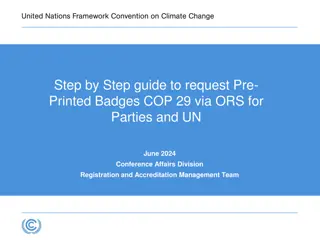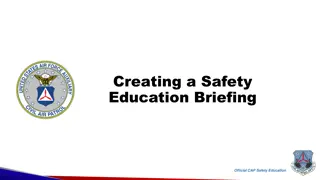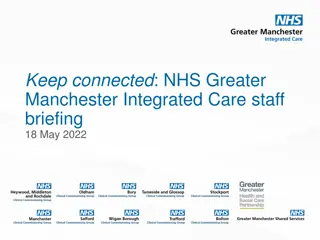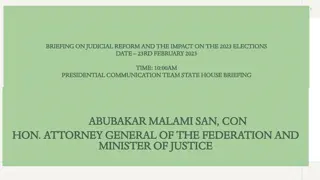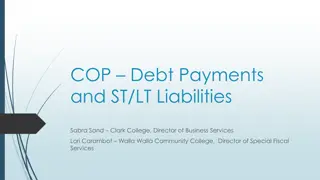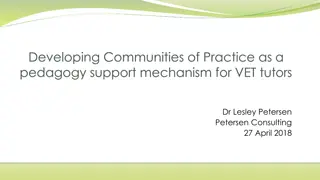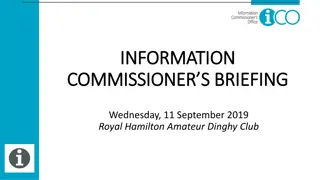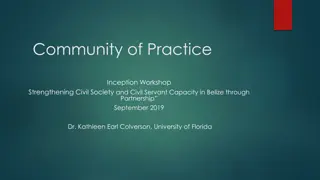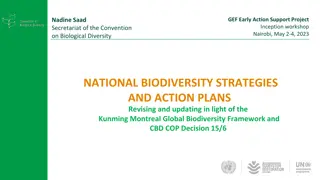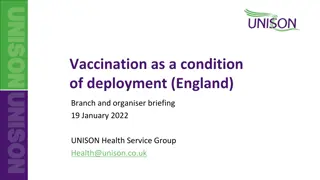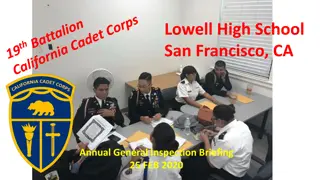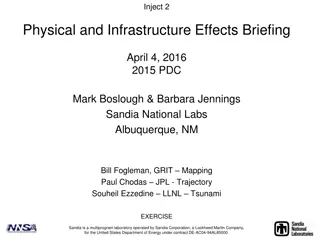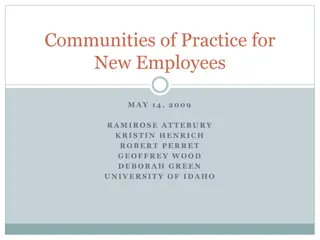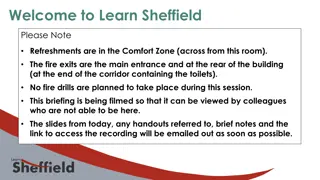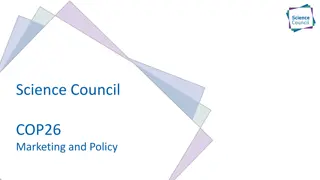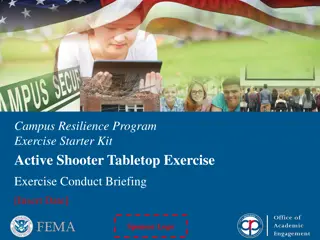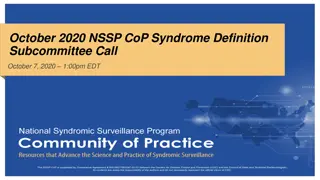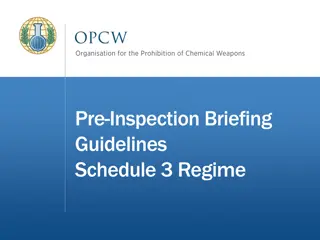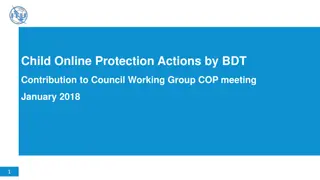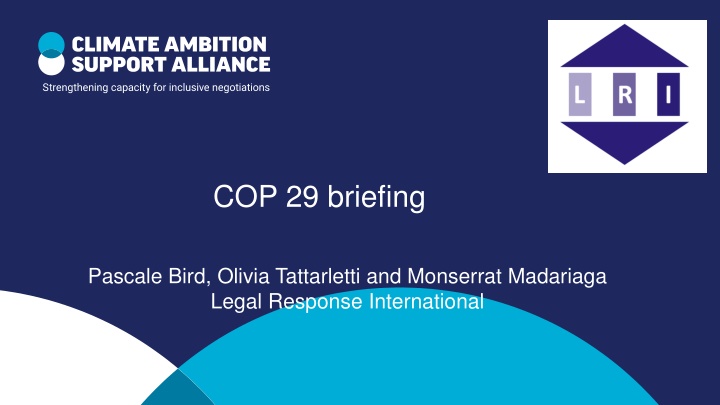
COP 29 Briefing on Finance, NCQG, and Climate Negotiations
Explore the latest updates from COP 29 briefing covering topics like finance under the UNFCCC, the New Collective Quantified Goal (NCQG), and ongoing climate negotiations. Discover insights on mobilizing climate finance, country obligations, and key elements still under discussion.
Download Presentation

Please find below an Image/Link to download the presentation.
The content on the website is provided AS IS for your information and personal use only. It may not be sold, licensed, or shared on other websites without obtaining consent from the author. If you encounter any issues during the download, it is possible that the publisher has removed the file from their server.
You are allowed to download the files provided on this website for personal or commercial use, subject to the condition that they are used lawfully. All files are the property of their respective owners.
The content on the website is provided AS IS for your information and personal use only. It may not be sold, licensed, or shared on other websites without obtaining consent from the author.
E N D
Presentation Transcript
COP 29 briefing Pascale Bird, Olivia Tattarletti and Monserrat Madariaga Legal Response International
OVERVIEW Finance and the New Collective Quantified Goal The Global Stocktake, NDCs and Mitigation Work Programme Adaptation Loss and Damage Just Transition Response measures
Finance under the UNFCCC In the context of CBDRRC, developed countries have financial obligations towards developing countries to support the implementation of their commitments under the Convention and the Paris Agreement. (Article 4.3 UNFCCC) The developed country Parties ( ) shall provide new and additional financial resources. Introduction to LRI Climate negotiations in context Implementation at national level Final considerations 199Q1992&1992A the Convention. (Article 9.1 PA) under the Convention will depend on the effective implementation by developed country Parties of their commitments under the Convention related to financial resources and transfer of technology ( ) (Article 4.7 UNFCCC) The extent to which developing country Parties will effectively implement their commitments Developed country Parties shall provide financial resources to assist developing country Parties with respect to both mitigation and adaptation in continuation of their existing obligations under from a wide variety of sources, instruments and channels (Article 9.3 PA). Developed country Parties should continue to take the lead in mobilizing climate finance
The New Collective Quantified Goal: process Collective goal for developed countries to jointly mobilise USD 100 b/year established at COP 15 (2009) and extended at COP 21. Assessment: insufficient, not delivered and unbalanced (GST1, 2023) COP 21 (2015) when extending the previous goal decided that by 2025 the CMA 6 would set a NCQG from a floor of USD 100 B. CMA 3 (2021) agreed on a process for deliberation between 2022 and 2023: ad hoc work programme (AHWP) with Technical Expert Dialogues (TEDs), high-level ministerial dialogues, stocktakes, and guidance by the CMA. CMA 5 (2023) agreed to move to a mode of work that allowed to discuss on the basis of a draft decision. Introduction to LRI Climate negotiations in context Implementation at national level Final considerations 199Q1992&1992A - High Level Ministerial Dialogue: 9 October 2024 - Additionally, COP 29 Presidency facilitated an Informal heads of delegation meeting on the NCQG (8 October) - Input for the COP: New ADWP co-chair s report including draft text, and report to the CMA. 2024 negotiations: - Second meeting of ADWP: 4 sessions during the Bonn negotiations. Co- hairs presented a 63 pages draft text. - 10th and 11th TED: June and September.
COP 29: agreeing on the elements of the NCQG Parties still need to agree on the key elements of the goal (and developed/developing countries are divided). - The quantum: how much. Consideration of developing countries needs/ bottom up and top-down approaches. SCF 2024 report only mapped 48% of needs. Introduction to LRI Climate negotiations in context Implementation at national level Final considerations 199Q1992&1992A - Mobilization or provision? - Single layer (which requires a clear definition of climate finance) or multi-layer (core for public finance). - Structuring allocation: subgoals? Including one on L&D? See LRI advice on arguments for and against a L&D subgoal. - The quality: - Forms: concessional? Grants? Loans? 72% of climate finance is debt based (OECD, 2023).Other innovative sources? See LRI literature review on sources of funding. - Allocation: accessible, predictable. - The nature and structure:
- Contributors base: - No change: Developing countries position. Legal basis: financial obligations under the convention and the PA (to be implemented by the goal). CBDRRC. - Change: Developed countries position. This should be a global effort. Some emerging economies have grown and bear responsibility. Introduction to LRI 199Q1992&1992A -Transparency and Monitoring: Link to the ETF or delegate to the SCF -Timeframe: a flexible goal
Link Introduction to LRI 199Q1992&1992A
The Financial Mechanism Operated by the Global Environmental Facility and Green Climate Fund (previously, the World Bank). Guidance from COP 29. Least Developed Countries Fund. Adaptation Fund (report on doubling of adaptation finance and governance at COP 29) Loss and Damage Fund (COP 28). Report and guidance from COP 29. The Standing Committee on Finance Introduction to LRI Climate negotiations in context Implementation at national level Final considerations 199Q1992&1992A These report to the COP/CMA, which provides guidance.
Global Stocktake (GST) Assessment of Parties collective efforts towards the implementation of the the Paris Agreement purpose and long-term goals (Article 2 I a-c) CMA 5 (2023) performed the first GST, as mandated by Article 14 of the Paris Agreement. Will take place every 5 years. GST 1: Decision 1 CMA/5 Introduction to LRI Climate negotiations in context Implementation at national level Final considerations 199Q1992&1992A equitable manner, accelerating action in this critical decade, so as to achieve net zero by 2050 in keeping with the science; and Phasing out of inefficient fossil fuel subsidies. - 193 paragraph decision capturing Parties' progress, gaps and challenges. - Emphasizes the need for urgent action and support to keep the 1.5 C goal within reach. But few operative texts. - Due to inform next round of NDCs. - Fossil fuels: calls parties to Transitioning away from fossil fuels in energy systems, in a just, orderly and LRI advice on language on fossil fuels in the GST decision.
GST in 2024 and CMA 6/COP 29 1) UAE GST Dialogue focusing on implementing the GST outcomes, which will be operationalised from CMA 6 (2024) and conclude at CMA 10 (2028) established in para. 97 of the GST 1 Decision. - SB 60 mandated to negotiate on the modalities, however, strong disagreement over scope arose. Is this to implement all GST outcomes or finance related ones only? - COP 29 provisional agenda placed this dialogue under finance. Introduction to LRI Climate negotiations in context Implementation at national level Final considerations 199Q1992&1992A 2) Annual GST Dialogue to facilitate sharing of knowledge on how the outcomes of the GST are informing the next round of NDC. established in para. 187 GST decision and took place at SB 60. 3) GST 1 review: Procedural and Logistical Elements of the Overall Global Stocktake Process established by CMA 1. GST decision established it to commence at SB 60 and conclude at CMA 6.
Nationally Determined Contributions (NDCs) NDCs are the driving (procedural) obligation of Parties under the PA: to submit and update a mitigation NDC. It captures what a Party intends to achieve. Introduction to LRI Climate negotiations in context Implementation at national level Final considerations 199Q1992&1992A Mitigation oriented regime. Developing countries tend to include adaptation, finance, L&D. Conditional elements in NDC (to support). NOT a legally binding obligation of a specific outcome (at the international level), i.e. no requirement to meet or comply with their commitments. Might be enforceable at the national level.
New NDCs to be submitted in 2025 GST1 (para 167) reaffirmed that successive NDCs must represent a progression beyond the Party s current NDC and reflect its highest possible ambition . NEW NDCs (third generation) to be submitted in 2025. Introduction to LRI Climate negotiations in context Implementation at national level Final considerations 199Q1992&1992A in new NDCs (June 2024). Only one from the 20 biggest FF producing countries mention GST annual dialogue on how the GST is informing the next round of NDCs. Summary report. IISD report on How the Transition Away From Fossil Fuel Production (GST 1) can be included decreasing production (EU).
Mitigation Work Programme (MWP) CMA 3 (2021) Parties established a work programme to urgently scale up mitigation ambition and implementation in this critical decade, complementary to the GST. CMA 4 (2022) Parties agreed on the scope and format of the MWP, which became known as the Sharm el- Sheikh mitigation ambition and implementation work programme. 2023/2024: Two dialogues on accelerating a just energy transition in 2023 and ahead of SB 60 (2024), a third dialogue and investment-focused event was held centred on Cities: buildings and urban systems. Introduction to LRI Climate negotiations in context Implementation at national level Final considerations 199Q1992&1992A Informal note and draft decision published by co- facilitators. SB60: Parties were invited to share views on these events and found strong disagreement. Some Parties wanted the MWP to be linked to GST outcomes(specially on FF) while LMDC and Arab Group opposed to such linkages. Rule 16. Provisional agenda for SBSTA 61 and SBI 61. Report by the Secretariat.
Context The effects of a changing climate are already being observed and experienced across the world. Developing countries are most affected. Adaptation means taking measures to reduce the negative effects of climate change or exploit the positive ones, by making appropriate adjustments. There is no one size fits all and interventions will vary, based on many factors, incl. local context. Recognised under the UNFCCC, dedicated article in the Paris Agreement (Article 7, PA)
Global Goal on Adaptation (GGA) Article 7.1, PA: Parties hereby establish the [GGA] of enhancing adaptive capacity, strengthening resilience and reducing vulnerability to climate change, with a view to contributing to sustainable development and ensuring an adequate adaptation response in the context of the temperature goal referred to in Article 2 In Dubai in 2023 (Decision 2/CMA.5) UAE Framework for Climate Resilience: a framework (voluntary targets) to guide the achievement of the GGA and review its overall progress was agreed UAE Bel m work programme: A two-year programme to develop indicators to measure progress toward the targets was launched
What to expect at COP 29? Disagreements persist in many areas, incl. inclusion of quantitative and qualitative targets to measure progress, embedding means of implementation in GGA framework, process versus outcome-based targets, etc. Decision on who will lead the process of developing indicators (Adaptation Committee / experts); clarity on experts engagement in process and criteria for indicator identification What is the final output expected in Belem? Means of implementation: How to measure the gaps in finance, technology and capacity building? Contribution to future global stocktakes
Other adaptation related negotiation themes National Adaptation Plans: Parties are mandated to assess progress made towards the formulation and implementation of NAPs. Review of the Adaptation Committee Adaptation finance: GST1 acknowledged that funding for adaptation will need to be significantly increased beyond the doubling provided for in Decision 1/CMA.3 to meet the urgent and evolving need to accelerate adaptation
Milestones on Loss and Damage Source: UNFCCC
Loss and Damage under the UNFCCC process Warsaw International Mechanism (WIM) Loss and Damage Fund and Funding Arrangements Executive Committee Santiago Network
Warsaw International Mechanism COP19 (2013) established the Warsaw International Mechanism for Loss and Damage associated with Climate Change Impacts (WIM) as the main vehicle in the UNFCCC process to address loss and damage Same decision also established its Executive Committee to guide the implementation of the WIM s core functions: o Enhancing knowledge and understanding of comprehensive risk management approaches to address loss and damage; o Strengthening dialogue, coordination, coherence and synergies among relevant stakeholders; and o Enhancing action and support, including finance, technology and capacity-building, to address loss and damage associated with the adverse effects of climate change, to enable countries to undertake actions.
Santiago Network CMA 2 (COP25): established the Santiago Network (SN) to catalyze technical assistance of organizations, bodies, networks and experts for the implementation of Loss & Damage CMA 3 (COP26): agreed Network s functions CMA 4 (COP27): decided on operational modalities and Network s structure, to include a secretariat, Advisory Body and a network of organisations, bodies, networks and experts (OBNEs)
Funding arrangements incl. a Loss and Damage Fund COP27/CMA4 established funding arrangements, including a Fund, dedicated to Loss and Damage COP28/CMA5 decisions operationalized the Fund and approved its Governing Instrument The Fund, to be known as Fund for responding for Loss and Damage, will be a multilateral financing channel that aims: to assisting developing countries that are particularly vulnerable to the adverse effects of climate change, in responding to loss and damage with a focus on addressing loss and damage by providing and assisting in mobilising new and additional resources
Recent developments and what to expect at COP29 WIM: TORs for 3rd review of WIM (incl. ExCom) prepared at SB60; COP29/CMA6 to conduct WIM review COP29/CMA to continue consideration of WIM governance Annual report of the ExCom Santiago Network: Advisory Board met three times this year, deciding on headquarters location (Geneva), two-year work programme, indicative budget for 2024 and guidelines for designation of OBNEs, responding to requests for assistance, managing funding and conflicts of interest AB will recommend draft rules of procedure for adoption at COP29/CMA6 Annual report of SN will be approved
Recent developments and what to expect at COP29 Fund for responding to Loss and Damage: LDF Board met three times this year to start process of operationalising it. One more meeting scheduled in December. The Philippines to be host of the Board. At last meeting, the Board appointed the first LDF Executive Director. It also approved all key documents that will allow World Bank to act as interim trustee and host the Fund s secretariat The fourth Board meeting will begin discussions on design of the Fund, incl. on modalities for direct access and direct budget support, minimum fiduciary standards and environmental and social safeguards for direct access entities, and a minimum allocation floor for LDCs and SIDS At COP29, launch of the annual high-level dialogue on coordination and complementarity with reps of entities forming part of funding arrangements Approval of contractual arrangements between COP, CMA and Fund to ensure it is accountable and functions under guidance of COP and CMA
Just transition - introduction Features in two negotiation streams Response measures SBI/SBSTA - Matters relating to the forum on the impact of the implementation of response measures serving the Convention, the Kyoto Protocol and the Paris Agreement COP/CMA/CMP - Report of the forum on the impact of the implementation of response measures Just transition work programme (JTWP) SBI/SBSTA - United Arab Emirates just transition work programme Introduction to LRI Climate negotiations in context Implementation at national level Final considerations 199Q1992&1992A CMA - United Arab Emirates just transition work programme
Just transition work programme J T W P JTWP established in 2022 in Egypt through Decision 1/CMA.4 Objective: discussing pathways to achieving the Paris Agreement goals under a just and equitable transition Introduction to LRI Climate negotiations in context Implementation at national level Final considerations 199Q1992&1992A Two annual dialogues in hybrid format Further developed in 2023 in the UAE through Decision 3/CMA.5 Modes of work: Joint contact group convened at each of the SBI and SBSTA sessions An annual high-level ministerial roundtable
JTWP core elements 1. Just transition pathways to achieving the Paris Agreement goals under Article 2; 2. Just and equitable transition pathways that include energy, socioeconomic, workforce and other dimensions, based on nationally defined development priorities and including social protection; 3. Opportunities, challenges and barriers relating to sustainable development and poverty eradication; 4. Approaches to enhancing adaptation and climate resilience; 5. Just transition of the workforce and the creation of decent work and quality jobs; 6. Inclusive and participatory approaches; 7. International cooperation as an enabler of just transition pathways. Introduction to LRI Climate negotiations in context Implementation at national level Final considerations 199Q1992&1992A Broad remit: Different meanings of just transition and different priorities for transition pathways.
JTWP in 2024 Two dialogues have taken place: 2-3 June: Just Transition pathways to achieving the goals of the Paris Agreement through NDCs, NAPs and LT-LEDs SB Chairs informal summary (bit.ly/JTWPdialogue1) 2-3 October: Ensuring support for people-centric and equitable just transition pathways with a focus on the whole-of-society approach and the workforce Introduction to LRI Climate negotiations in context Implementation at national level Final considerations 199Q1992&1992A CMA 6 (November 2024): annual summary report on the dialogues, negotiations with a view to recommending a draft decision to CMA 6, annual high-level ministerial round table on just transition SBSTA/SBI 60 session in June in Bonn: Discussions on a draft decision text on the implementation of the JTWP (no agreement) Agreed to continue consideration of the matter at SB 61
*Upcoming* just transition explainer JTWP key issues SB 60 informal note by co-chairs bit.ly/JTWPSB60 Lack of common understanding on the concept Introduction to LRI Climate negotiations in context Implementation at national level Final considerations 199Q1992&1992A Modalities: whether existing ones are sufficient or additional ones are needed (e.g. some parties called for further dialogues) Continuation of work: Whether to request constituted bodies to report on integration of JT into their processes A proposal from G77+China to establish a work plan for the work programme, opposed by the US
Response measures - introduction Mainly measures to reduce emissions The Convention, the Kyoto Protocol, and the Paris Agreement all recognise that implementing response measures can impact countries economies Introduction to LRI Climate negotiations in context Implementation at national level Final considerations 199Q1992&1992A Undertakes technical work, e.g. prepares case studies, technical papers etc. 2011: Forum to understand and address these impacts was set up 2018: Katowice Committee of Experts on the Impacts of the Implementation of Response Measures (KCI) created to support the Forum s work
LRI advice on the functions of the forum bit.ly/RMforum Response measures forum & KCI Single platform for the work of the COP, CMP and CMA on the issue Common work programme and jointly implement a 6-year workplan Work programme has 4 areas: Introduction to LRI Climate negotiations in context Implementation at national level Final considerations 199Q1992&1992A Provide a platform for countries to share information, experiences with a view to recommending specific actions; provide recommendations to the SBs who then recommend them to the COP, CMP, CMA; promote action; enhance capacity; enhance cooperation; input to the GST; database of tool and methodologies 1.Economic diversification and transformation; 2.Just transition of the workforce and the creation of decent work and quality jobs; 3.Assessing and analysing the impacts of the implementation of response measures; 4.Facilitating and building capacity for the identification, development, customization and use of tools and methodologies to assess the impacts of the implementation of response measures. Forum and KCI have 9 functions:
Response measures in 2024 Forum convened at SBI 60 and SBSTA 60 Held 2 technical events on guidelines and policy frameworks to promote just transition within and across sectors, and on understanding the positive and negative impacts of low and zero- emission transportation technologies Introduction to LRI Climate negotiations in context Implementation at national level Final considerations 199Q1992&1992A KCI will consider updates to its rules of procedure Started developing its new five-year work plan In discussions on the JTWP, G77+China expressed the view that it may no longer be beneficial to include JT within the KCI At SB 61 Forum will continue developing the work plan taking into account a non-paper containing a table of activities to recommend a draft decision for consideration and adoption at COP 29, CMP 19 and CMA 6
Other agenda items Sharm el-Sheikh joint work on implementation of climate action on agriculture and food security (SBSTA/SBI) Matters relating to the operation of the clean development mechanism (SBSTA/CMP) Matters relating to Article 6 of the Paris Agreement (SBSTA/CMA) Periodic review of the long-term global goal under the Convention and of overall progress towards achieving (COP) Matters relating to technology development and transfer: joint annual report of the Technology Executive Committee and the Climate Technology Centre and Network (SBSTA/SBI/COP/CMA) + Technology implementation programme (CMA) + Linkages between the Technology Mechanism and the Financial Mechanism; and Poznan strategic programme on technology transfer (SBI/COP) Reporting and review pursuant to Article 13 of the Paris Agreement: provision of financial and technical support to developing country Parties for reporting and capacity-building (SBI/CMA) Matters relating to Action for Climate Empowerment (SBI), Gender and climate change (SBI/COP) Research and systematic observation (SBSTA), Facilitating dialogues on mountains and climate change (COP) Matters relating to capacity-building (SBI/COP/CMA/CMP)
Relevant resources Guide to the Paris Agreement bit.ly/PAGuideEN Explainer on Loss and Damage bit.ly/LDexplainer141 Explainer on the New Collective Quantified Goal on Finance bit.ly/NCQG141 SB60 Outcomes Summary bit.ly/SB60SummaryENG Paris Agreement A to Z App LRI advice database https://legalresponse.org/legal- assistance/ COP29/CMA6/SB61 provisional agendas: https://unfccc.int/cop29#sessions
THANK YOU ! enquiries@legalresponse.org www.legalresponse.org


